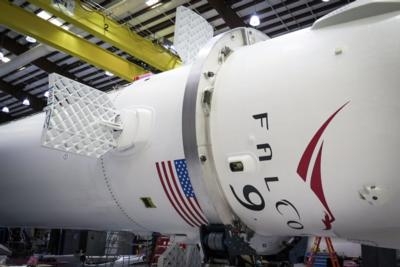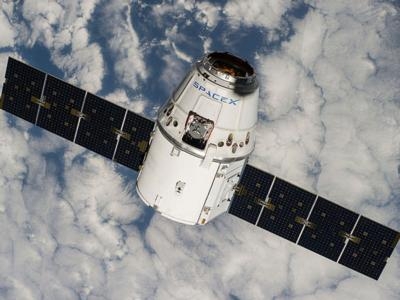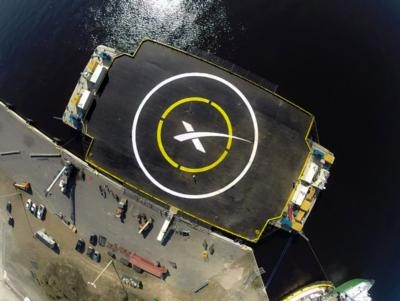Target Wise, They ‘Nailed It’ – Now, On To Greater Challenges
By ANN Space Correspondent, Wes Oleszewski
Standing on the upper deck of my home and looking out across Chesapeake Bay toward the Atlantic, I spotted a tiny orange pinpoint of light screaming across the clear winter sky.

Traveling from south to north, and elevated just about where a Space Shuttle mission to the International Space Station (ISS) should be (back in the days when we had a shuttle), I was sure that I was watching the SpaceX Falcon 9 boosting the Cargo Resupply (CRS) 5 mission.
Freezing my tail off at just before five o’clock in the morning, I did my best to keep my eye on that pinpoint of orange light. Suddenly it flashed bright white!
I thought to myself, “that must be MECO” (Main Engine Cutoff).
The pinpoint was gone for about as long as it took for me to whisper that thought to myself -- and then there was a second flash that was about three times brighter. Stepping back into the house, I heard over my computer that MECO had taken place and the Dragon spacecraft was on its way to the ISS.
The CRS-5 mission had been successfully launched.
That is what this launch of this Falcon 9 was actually all about; the CRS-5 mission.
Yet, for many in the SpaceX fan club, the CRS-5 mission took a back seat to something that seemed way more “cool.” That something was an attempt by SpaceX to soft-land the Falcon 9’s first stage on a barge positioned out in the Atlantic Ocean.

For months there has been an Internet orgy of drooling speculation and fantasy about how awesome that first landing was going to be. Often, without a single consideration of the complexity involved in landing a huge rocket stage on a floating barge, the rabid fans raved on from behind their keyboards.
Indeed; this was not only going to be awesome, but SpaceX (according to their fans), was going to make it look easy.
In the end the stage ended up crashed in pieces all over the barge and the fans were left to mumble, “bummer.”
Yet… this was not a “bummer” at all -- in fact, it was an amazing accomplishment.
Sure, the true mission of the launch was to place in orbit the CRS-5 Dragon spacecraft -- which SpaceX successfully did.
That said, a secondary developmental aspect of the flight was to attempt to soft land the Falcon 9 first stage -- something that could be considered nearly impossible. On a previous attempt, they managed to hit the Atlantic Ocean and gained data on how to further advance the effort.
This time, though, they actually hit the barge. Again, they have gained a large volume of data -- and what this means is that SpaceX is now much, much closer to actually solving the equation and accomplishing the soft landing of a spent first stage.

Of course; they are still nowhere near routinely landing these stages on dry land as if they were ‘Thunderbird 3.’ The local political (especially environmental) roadblocks will likely be more difficult to overcome than the engineering of the landing itself.
Additionally; it is important to keep in mind that SpaceX is struggling to consistently get their Falcon 9 version 1.1 off the ground on a routine basis -- and thus their demonstrating the ability to get the stages landed on a routine basis is probably nowhere in sight.
Add to that, the fact that SpaceX is planning (some day) to launch their Falcon 9 Heavy, which consists of three Falcon 9 boosters strapped together, and return them in a fly-back landing. Now they will have three huge thrusting boosters headed for Florida’s space coast simultaneously. Not the sort of thing that the owners of the huge cruise ships docked at nearby Port Canaveral, or the owners of expensive hotels and condominiums, really want to mention to their insurance companies.
So… was Saturday morning’s crash of the Falcon 9 first stage on its target barge something to be gloomy about?
No.
That is, unless you would look at an encyclopedia of data filled with clues on how to accomplish the near-impossible and be bummed out about it.
My bet is that, as you read this, SpaceX engineers are eagerly sifting through that data so they can apply changes to their next attempt as Elon Musk breathes down their necks.
(ANN Thanks John Atkinson for the use of his SpaceX cartoon/illustration.)



 ANN's Daily Aero-Linx (05.02.24)
ANN's Daily Aero-Linx (05.02.24) ANN's Daily Aero-Term (05.02.24): Touchdown Zone Lighting
ANN's Daily Aero-Term (05.02.24): Touchdown Zone Lighting Aero-News: Quote of the Day (05.02.24)
Aero-News: Quote of the Day (05.02.24) ANN FAQ: Contributing To Aero-TV
ANN FAQ: Contributing To Aero-TV NTSB Final Report: Cirrus Design Corp SR20
NTSB Final Report: Cirrus Design Corp SR20








